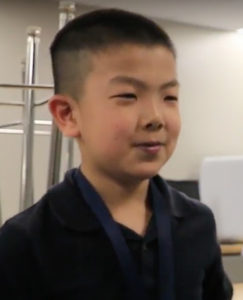Music: http://www.bensound.com/royalty-free-music
STEM school puts students in charge of own learning
Kingsten Lin is 8 years old and already knows that he learns better by trying things and working with his classmates – instead of sitting in a room and listening to a teacher.
“I need to be involved in experimenting,” said the third-grade student at the School of Innovation in the Willoughby-Eastlake District. “I like solving design challenges and interactive logic.”
He and 224 other students in the third, fourth and fifth grades were the first students to attend the new school that that has made its home in a modern building once owned by the Eaton Corporation.
The School of Innovation, with its focus on Science, Technology, Engineering and Math, will one day house third through 12th grade, with a new class of third graders joining each year.
Principal Brian Patrick said he believes his students will change the world and that’s the goal that he and the team of teachers set out to meet by giving students design challenges, discussing world problems and then granting them access to 3-D printers, laser cutters and other sophisticated machinery.
“This way of learning can be a little unnerving. You have to let go of your anxiety and let people have freedom,” he said.
The leaders of the Willoughby-Eastlake district worked with a broad cross-section of stakeholders to design the school, including consultants from T.I.E.S., who helped develop the basic principles governing school operations.
The school is designed to provide students with “a standards-based, design-focused curriculum that is centered on solving real-world problems and tooling students with twenty-first century STEM skills.”
The School of Innovation partners with higher education, business and industry and non-profits to pursue its mission of creating “life-long learners, intrinsically motivated to solve the most challenging problems facing the globe and committed to Willoughby-Eastlake and northeast Ohio.”
Three days before the end of the first school year, the school’s 75 fourth graders gathered in a large meeting room on the main floor of the school to sell items they had made from recycled materials.
Bracelets crafted from used duct tape, laser-cut bookmarks, necklaces made out of paperclips and drawings the students penned themselves were on-sale. Students produced and marketed their items as teams, with some aggressively marketing their goods through video commercials they created or jingles they wrote.
Proceeds will be used to buy T Shirts carrying the school’s name.
The recycled goods marketplace, where students charted their costs and proceeds on Excel spreadsheets, was one of many projects, called “capstones” the students tackle as part of their learning at the school.

Kingsten Lin pictured above.
Kingsten said the concept of learning follows the principles of design, “Ask, explore, plan, create, test, redesign.”
“I forgot how to just sit in a regular classroom. I don’t think I’d want to go back to that,” he said.



